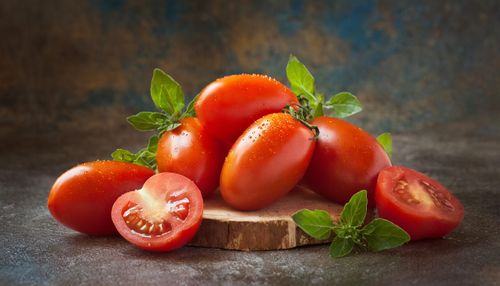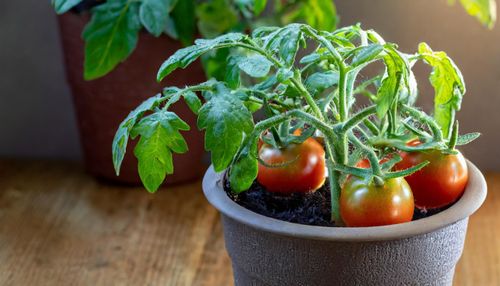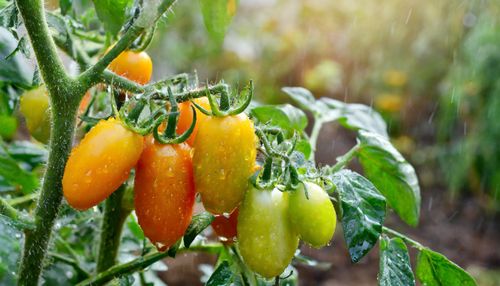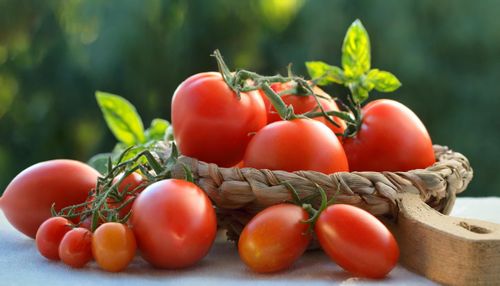Roma Tomatoes
Explore the flavors of Roma tomatoes, known for their meaty texture and ideal for crafting rich sauces. Discover tips on growing and caring for Roma tomatoes.

Roma tomatoes, scientifically known as Solanum Lycopersicum var. Roma, stand as a distinctive variety revered in the culinary world for their exceptional attributes. Also commonly referred to as plum tomatoes or paste tomatoes, these elongated, oval-shaped gems are renowned for their rich flavor and meaty texture, making them a staple ingredient in various culinary creations. We invite you to read our short guide.
What are Roma Tomatoes?
Roma tomatoes are a widespread variety of tomatoes with an oval shape and fewer seeds than other types. They are known for their firm texture and low moisture content, making them ideal for cooking, canning, and making sauces. Romas are commonly used in Italian cuisine for their rich, sweet flavor.
Roma Tomato Characteristics
Discover the essence of Roma tomatoes through seven key characteristics:
- Rich, sweet flavor: Roma tomatoes have a deep, sweet flavor with low acidity, making them perfect for sauces, salsas, and salads.
- Meaty texture: This characteristic of Roma tomatoes measures around 3 inches long. Roma tomatoes are known for their thick, meaty flesh, which makes them ideal for cooking and preserving.
- Few seeds: Compared to other tomato varieties, Roma tomatoes have relatively few seeds, giving them a firmer texture and a higher concentration of flesh.
- Oblong shape: Roma tomatoes are typically oval-shaped, with a slightly pointed end, making them easy to slice and dice for cooking.
- Thick skin: The thick skin of Roma tomatoes helps them hold up well to cooking, grilling, and roasting without falling apart.
- High lycopene content: Roma tomatoes are rich in lycopene, a powerful antioxidant linked to various health benefits, including reducing the risk of certain diseases.
- Versatilit: Roma tomatoes are incredibly versatile and can be used in various dishes, from soups and stews to bruschetta and Caprese salad. Roma tomatoes are also famous for making and preserving tomato sauce in the off-season.
Roma tomatoes showcase their culinary prowess in each characteristic, earning them a cherished spot in kitchens worldwide.
Roma VF, like all tomatoes, show resilience.
Variety Roma VF is a variety of tomatoes known for its disease resistance, specifically to Verticillium and Fusarium wilts. It produces high yields of bright red, meaty fruits perfect for canning and making sauces. The determinate plants are relatively compact, making them suitable for smaller gardens or containers. Roma VF tomatoes are known for their rich, slightly acidic flavor and are a popular for cooking and preserving.
How to Grow Roma Tomatoes from Seeds Indoors
To grow Roma tomatoes from seeds indoors, start 6-8 weeks before the last frost. Use seed trays, quality seeds, and a well-draining mix. Plant 2-3 seeds per container, cover lightly and keep warm (70-80°F). Ensure ample light from a sunny window or grow lights for 14-16 hours daily; tomatoes need this for optimal growth. Keep soil consistently moist. Transplant seedlings to larger pots after true leaves appear. Harden off before transplanting outdoors, choosing a sunny spot with well-draining soil. Provide support as they grow, stake, or cage for optimal development. Consistently water and feed with a balanced fertilizer.

Common Pests and Diseases
Cultivating Roma tomatoes comes with the responsibility of managing potential threats. Here's a concise guide to common pests and diseases that tomatoes might encounter:
Posts: Roma tomatoes are also susceptible to various pests:
- Aphids: Tiny insects on new growth. Use insecticidal soap or natural predators.
- Whiteflies: Small, white insects under leaves. Employ insecticidal soap or reflective mulch.
- Hornworms: Large, green caterpillars. Handpick or use Bacillus thuringiensis (Bt) when you grow tomatoes.
Diseases:
- Early Blight: Dark circles on lower leaves. Remove affected leaves and apply fungicides.
- Late Blight: Water-soaked lesions, rapid browning. Remove affected plants and use copper-based fungicides.
- Verticillium Wilt: Yellowing, wilting. Plant resistant varieties and practice crop rotation.
- Fusarium Wilt: Wilting, yellowing. Plant resistant varieties and practice soil sterilization.
- Blossom End Rot: Dark spots on tomatoes. Maintain consistent watering and ensure proper calcium levels.
Stay vigilant, detect issues early, and act promptly to ensure a thriving crop of Roma tomatoes. Regular inspections and preventive measures are crucial for a healthy and fruitful harvest.
How to Protect Roma Tomatoes from Pests and Diseases
To protect Roma tomatoes from pests and diseases, it's advisable to rotate crops that grow tomatoes. It is essential to practice good garden hygiene. This includes:
- Removing any decaying or dead plant matter, as it can attract pests and harbor disease.
- Encouraging beneficial insects such as ladybugs and lacewings can also help keep pest populations in check.
- Using row covers or netting can help protect tomatoes from pests like aphids, flea beetles, and hornworms while preventing the spread of diseases by keeping out infected insects.
- Additionally, rotating crops and not planting Roma tomatoes in the same spot year after year helps, as tomatoes grow better in varying soil.
- Applying organic pesticides or creating homemade remedies like garlic and pepper sprays can also effectively control pests.
- Regularly inspecting Roma tomato plants for signs of pests or diseases can help catch and address issues before they become widespread.
By implementing these practices, gardeners can help protect their Roma tomatoes and ensure a healthy and abundant harvest.

How to Care for Roma Tomatoes
To correctly prune and train Roma tomato plants, it is essential to start early in the growing season:
- Begin by removing any small shoots that emerge in the crotch of the main stem and side branches. This process will help to encourage Roma tomatoes, like all tomatoes, to focus their energy on developing fruit-bearing solid branches.
- Additionally, regularly remove any suckers that develop in the leaf axils.
- As the plant grows, use stakes or cages to support the main stem and side branches, and gently tie them to the supports as needed. This will help control the plant's growth and ensure it is adequately supported as the fruit develops.
By consistently pruning and training Roma tomato plants, gardeners can help to maximize their yield and promote healthy growth.
Proper Watering and Fertilization for Roma Tomatoes
Proper watering and fertilization are essential for growing healthy and productive Roma tomatoes. These plants require consistent moisture, so it is vital to water them deeply and regularly, ensuring that the soil is evenly moist but not soggy.
It is best to water Roma tomatoes in the morning to allow the foliage to dry before evening, reducing the risk of disease.
Fertilizing Roma tomatoes with a balanced, slow-release fertilizer can help promote vigorous root growth and abundant fruit production. Following the recommended fertilization schedule is essential for best results and avoiding over-fertilizing, which can lead to excessive foliage growth at the expense of fruit development.
Harvesting and Storing Roma Tomatoes
Roma tomatoes are typically ready to harvest 70-80 days after planting. When the fruits are fully ripe and have a deep red color, it is time to pick them. Carefully twist the tomatoes off the vine, making sure not to damage the plant. It is best to harvest in the morning when the fruits are cool and firm.
Once harvested, Roma tomatoes should be stored at room temperature until they fully ripen, which can take anywhere from a few days to a week. To extend their shelf life, place them in a single layer in a cool, dry place with good air circulation. It's important to check on them regularly and use any that show signs of ripeness to prevent them from spoiling.
Once fully ripened, they can be stored in the refrigerator for up to a week. For longer-term storage, varieties of Roma tomatoes can also be canned or frozen to enjoy their fresh flavor all year round.
Growing Roma Tomatoes in Full Sun and Indoors
Roma tomatoes are a popular variety for growing in full sun, as they require at least 6-8 hours of direct sunlight daily to thrive. When planting them outdoors, it's important to choose a location with well-draining soil and to space the plants 24-36 inches apart to allow for proper air circulation. Regular watering and feeding with a balanced fertilizer will help produce a bountiful crop of juicy, meaty Roma tomatoes.
However, if outdoor space is limited, Roma tomatoes can also be grown indoors with the help of grow lights. When cultivating Roma tomatoes indoors, it's crucial to provide them with adequate light, either by placing them in a sunny window or by using grow lights for at least 12 hours a day. Additionally, proper air circulation, regular watering, and the use of a well-balanced fertilizer are essential for indoor Roma tomato plants to thrive and produce a plentiful harvest.

Roma Tomatoes vs Other Tomato Varieties
Roma tomatoes have a thicker flesh and fewer seeds than other tomato varieties. They are also known for their low moisture content and rich, tangy flavor. Other tomato varieties, such as beefsteak or cherry tomatoes, are better suited for fresh eating due to their juicier texture and sweeter taste.
Differences between Roma and San Marzano Tomatoes
Roma tomatoesare known for their oblong shape and meaty texture, making them great for sauces and canning. San Marzano tomatoes, like Roma tomatoes, are also indeterminate varieties. On the other hand, they are prized for their sweet flavor and low acidity, making them perfect for making tomato paste and pizza sauce. Both are popular choices in Italian cuisine but have distinct uses and flavor profiles.
Advantages of Growing Roma Tomatoes in Your Garden
- Culinary Excellence: Roma tomatoes, with their elongated shape and meaty texture, are perfect for creating thick sauces and pastes, elevating your culinary endeavors.
- Disease Resistance: Roma tomatoes exhibit resilience against common threats like Verticillium and Fusarium wilt, ensuring a robust and healthy crop for a reliable harvest.
- Versatility: These tomatoes offer versatility, suitable for canning, drying, and various culinary creations, and provide a range of options for home cooks and chefs.
- Adaptability: Thriving in different growing conditions, Roma tomatoes are adaptable and well-suited for novice and experienced gardeners, making them an accessible choice for all.
- Mediterranean Heritage: With a cultural touch, Roma tomatoes contribute to classic dishes like bruschetta and pasta sauces, adding a Mediterranean flair to your garden and culinary creations.
Growing Roma tomatoesin your garden can provide a bountiful harvest of flavorful, versatile tomatoes used in various culinary applications. Whether you are a seasoned gardener or a beginner, Roma tomatoes are an excellent option for anyone looking to cultivate their produce at home.